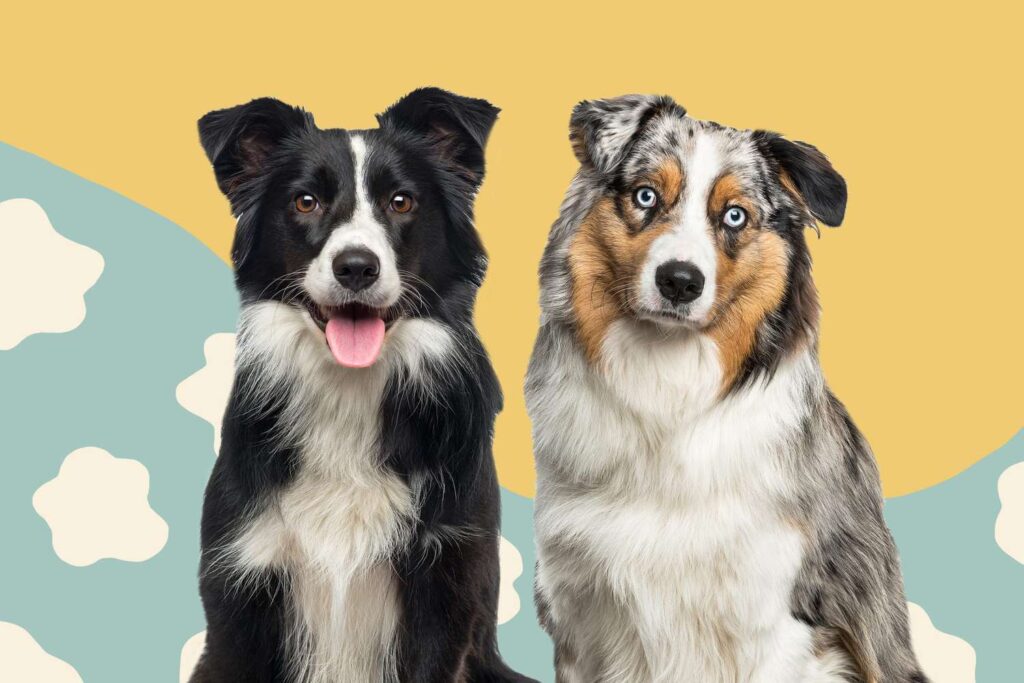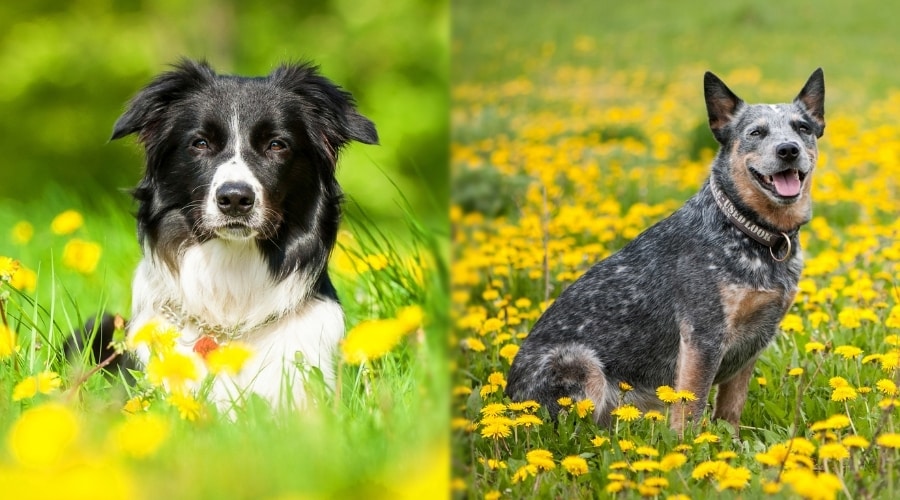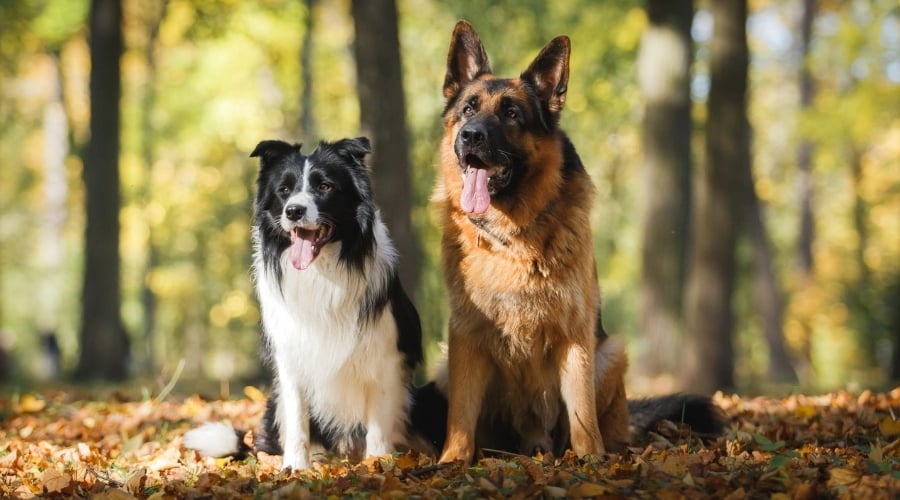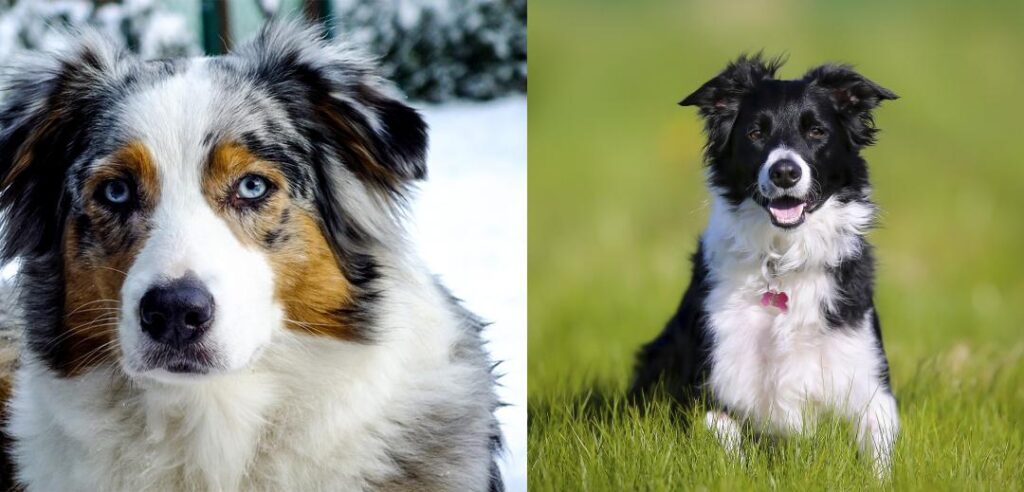Are you curious about the differences between Border Collies and other herding breeds? Well, you’ve come to the right place! In this article, we will delve into the key distinctions between Border Collies and other herding breeds, giving you a better understanding of what sets them apart.
When it comes to herding potential, Border Collies are often considered the crème de la crème. Their intelligence, agility, and natural instinct make them exceptional herders. They are renowned for their ability to anticipate and react to the movements of livestock, making them highly efficient working dogs. However, other herding breeds such as the Australian Shepherd, Australian Cattle Dog, and German Shepherd, among others, also possess strong herding instincts, although their herding styles may differ.
Border Collies stand out with their intense drive and focus. They have an incredible work ethic and are always ready to please and impress their handlers. Other herding breeds, while still driven and attentive, may exhibit different traits that make them better suited for specific herding tasks. For example, the Australian Shepherd is known for its versatility and adaptability, able to work in various herding situations with different types of livestock.
In the upcoming article, we will explore the physical, temperamental, and training differences between Border Collies and other herding breeds. Whether you’re a herding enthusiast or simply interested in learning more about these remarkable dogs, stay tuned to gain a deeper understanding of the distinctions between Border Collies and other herding breeds.

Border Collies: The Ultimate Herding Dogs
When it comes to herding livestock, Border Collies are often regarded as the ultimate herding dogs. Their intelligence, agility, and unparalleled work ethic make them well-suited for this demanding task. However, they are not the only herding breed out there. In this article, we will compare Border Collies with other popular herding breeds, such as Sheepdogs and Cattle Dogs, to explore the key differences between them.
Origin and History of Border Collies
Border Collies have a fascinating history that dates back to the 19th century in the border region between Scotland and England. They were initially bred for their herding abilities and were highly valued by shepherds for their intelligence and natural instincts. Today, they are still widely used as working dogs on farms and ranches around the world.
Physical Characteristics of Border Collies
Border Collies are known for their athletic build and medium size. They have a well-muscled body, a sleek coat that can be either smooth or rough, and expressive oval eyes that captivate anyone who gazes into them. Their ears are usually erect or semi-erect, and their tail is often carried low or in a slight curve when at rest.
Temperament and Personality of Border Collies
Border Collies are renowned for their high intelligence and ability to think independently. They are incredibly attentive and have an uncanny ability to anticipate the needs of their handler. However, their intense drive and desire to work can sometimes make them restless and prone to problem-solving if not given sufficient mental and physical stimulation. Border Collies are also known for their extreme loyalty and devotion to their families, making them excellent companions and protectors.
Other Herding Breeds: A Different Approach to Herding
While Border Collies may be considered the gold standard in herding dogs, there are other herding breeds that have their unique approach to herding. Let’s take a look at Sheepdogs, Cattle Dogs, and Working Dogs to understand their characteristics and strengths.
Sheepdogs: The Traditional Herding Breeds
Sheepdogs, also known as shepherd dogs, have been bred for centuries to work with sheep. They possess a strong herding instinct and excel in gathering, driving, and keeping the flock together. Unlike Border Collies, Sheepdogs typically rely more on close control techniques and gentle nudging rather than using their intense stare or high energy levels. Some popular Sheepdog breeds include the Old English Sheepdog, the Australian Shepherd, and the German Shepherd.
Cattle Dogs: The Herders of the Ranches
Cattle Dogs, as the name suggests, are primarily bred for herding cattle. These dogs have a strong prey drive and excel in driving large herds efficiently. They are known for their athleticism, endurance, and determination. Cattle Dogs often use their bodies to nudge or grip the cattle to move them in the desired direction. Breeds like the Australian Cattle Dog and the Pembroke Welsh Corgi have been developed specifically for this purpose.
Working Dogs: The Versatile Herding Breeds
Working Dogs, also known as versatile herding breeds, are bred to handle various types of livestock, including sheep, cattle, and even poultry. These breeds are known for their adaptability and versatility in different herding situations. They are often highly intelligent, agile, and have a natural instinct for working with livestock. The Australian Kelpie and the Belgian Malinois are examples of working dogs that excel in various herding tasks.

Comparing Size and Appearance
Border Collies, Sheepdogs, and Cattle Dogs may fall under the broad category of herding dogs, but they differ significantly in terms of size and appearance. Let’s take a closer look at the distinguishing characteristics of each breed.
Border Collies: Athletic and Medium-Sized
Border Collies are of medium size, typically weighing between 30 to 45 pounds (13 to 20 kilograms). They are agile and athletic, allowing them to move with great speed and precision while herding. Their coats come in a variety of colors, including black and white, red and white, and tri-color, giving them a striking appearance that can vary from dog to dog.
Sheepdogs: Sturdy and Medium to Large-Sized
Sheepdogs are generally larger than Border Collies, with males weighing between 60 to 100 pounds (27 to 45 kilograms) and females weighing between 50 to 80 pounds (23 to 36 kilograms). They have a sturdy build, a dense double coat that provides protection from the elements, and a distinct mane of fur around their neck. Their colors can range from shades of black, gray, and white.
Cattle Dogs: Muscular and Medium-Sized
Cattle Dogs are muscular and compact in build, making them well-suited for the demanding task of herding cattle. They typically weigh between 30 to 50 pounds (14 to 23 kilograms) and have a short, weather-resistant coat that comes in various colors such as blue, red, or red mottled. Their appearance exudes strength and athleticism, with well-defined muscles and a powerful stance.
Diverse Herding Styles
While all herding breeds share the common goal of moving livestock, the way they go about accomplishing this task varies significantly. Let’s explore the different herding styles of Border Collies, Sheepdogs, and Cattle Dogs.
Border Collies: The Eye and Stalk Approach
Border Collies are well-known for their intense gaze, commonly referred to as “the eye.” They use their strong eye contact to control and guide the livestock. Their stalking approach involves crouching low and moving quietly, which helps them maintain control without causing unnecessary stress to the animals. This focused and methodical approach allows Border Collies to work efficiently even in challenging terrains.
Sheepdogs: The Close Control Technique
Unlike Border Collies, Sheepdogs rely more on close control as their primary herding technique. They work closely with the sheep, often moving in tight circles or weaving in and out of the flock to maintain order. Sheepdogs have a gentler approach, using their bodies to gently guide and encourage the sheep to move in a specific direction without causing panic or stress to the animals.
Cattle Dogs: The Nudging and Gripping Method
Cattle Dogs have a more assertive and physically demanding herding style compared to Border Collies and Sheepdogs. They often use their bodies to nudge or grip the cattle to direct them. This can involve nipping at the heels or biting lightly to gain the attention and compliance of the cattle. Cattle Dogs excel in driving and moving cattle efficiently over long distances, using their natural instincts and physical presence to maintain control.

Training and Intelligence
All herding breeds, including Border Collies, Sheepdogs, and Cattle Dogs, are highly intelligent and trainable. However, each breed may possess certain traits and characteristics that influence their approach to learning and training.
Border Collies: The Genius of the Herding World
Border Collies are widely regarded as one of the most intelligent dog breeds in the world. They are quick learners and excel in tasks that require problem-solving and decision-making. Border Collies thrive when provided with mental stimulation and challenging activities. Their intelligence, combined with their strong work ethic, makes them highly trainable and versatile in various herding tasks.
Sheepdogs: The Obedient and Focused Workers
Sheepdogs, like Border Collies, are known for their high level of intelligence and trainability. They are often eager to please their handler and possess a strong desire to work. Sheepdogs excel in tasks that require obedience, focus, and maintaining a strong bond with their handler. With consistent training and positive reinforcement, Sheepdogs can learn complex tasks and excel in various herding situations.
Cattle Dogs: The Independent and Resourceful Learners
Cattle Dogs, while equally intelligent, may exhibit a more independent and self-reliant streak compared to Border Collies and Sheepdogs. They have a strong instinct for problem-solving and can quickly assess a situation to determine the most effective course of action. Cattle Dogs respond well to training that allows them to use their natural instincts and encourages independent decision-making.
Herding Instincts and Working Drive
The primary purpose of herding breeds is to work with livestock, and their instincts and drive for performing this task vary among breeds. Let’s explore the herding instincts and working drive of Border Collies, Sheepdogs, and Cattle Dogs.
Border Collies: The Ultimate Herders
Border Collies have an innate herding instinct that often manifests from a young age. They possess a strong desire to work and an unparalleled working drive. Border Collies are known for their intensity and focus when herding, and their herding skills are often unmatched by other breeds. Their natural instincts to control and gather livestock make them highly sought after for herding competitions and working on farms and ranches.
Sheepdogs: The Expert Gatherers
Sheepdogs, as their name suggests, excel in tasks that involve gathering and keeping sheep together. They have a natural ability to read the sheep’s behavior and respond accordingly. Sheepdogs possess a strong herding instinct that pushes them to gather and protect the flock. Their patience, calm demeanor, and ability to anticipate the movements of the sheep make them highly efficient and effective herders.
Cattle Dogs: The Reliable Drivers
Cattle Dogs are bred specifically for the task of driving cattle, and their instincts reflect this specialization. They have a strong prey drive and natural herding instincts that allow them to control and move cattle efficiently. Cattle Dogs rely on their instincts, agility, and physical presence to drive cattle over long distances. Their ability to maintain control and effectively communicate with cattle make them reliable and highly valued herding partners.

Suitability for Different Livestock
While Border Collies, Sheepdogs, and Cattle Dogs all excel in herding, their specific characteristics and instincts may make them more suitable for different types of livestock. Let’s explore the suitability of each breed for different livestock.
Border Collies: The Sheep Whisperers
Border Collies are often lauded as the ultimate sheep herders. Their herding style, intelligence, and inherent ability to communicate with sheep make them well-suited for working with these animals. Border Collies have a natural instinct to guide and control sheep, ensuring that they move smoothly and efficiently. They are highly attuned to the body language and movement of sheep, making them the go-to breed for herding sheep.
Sheepdogs: The Sheep Specialists
As their name implies, Sheepdogs are specifically bred and trained to work with sheep. Their gentle demeanor and close control technique make them excellent at guiding and directing sheep. Sheepdogs have a natural instinct to anticipate the needs of the flock and work cooperatively to maintain order. Their ability to move quietly and efficiently among sheep and handle them with care makes them perfect partners for shepherds.
Cattle Dogs: The Ideal Partners for Cattle
Cattle Dogs are well-suited for working with cattle due to their strong instincts, athleticism, and assertive herding style. They excel in driving and controlling large herds of cattle, often using their physical presence to assert dominance. Cattle Dogs are highly effective in moving cattle over long distances, ensuring that the animals remain together and follow the desired route. Their innate ability to read cattle’s movements and respond accordingly makes them indispensable on ranches and cattle farms.
Exercise and Activity Requirements
All herding breeds, including Border Collies, Sheepdogs, and Cattle Dogs, have high energy levels and require regular exercise and mental stimulation to thrive. However, the specific exercise and activity requirements may vary among breeds.
Border Collies: The Energizer Bunnies
Border Collies are incredibly energetic and require a significant amount of exercise to satisfy their high energy levels. They thrive in an environment where they can engage in plenty of physical activities, such as long walks, runs, and games of fetch. Additionally, Border Collies also benefit from mental stimulation, such as puzzle toys and training sessions, to keep their minds sharp and prevent boredom.
Sheepdogs: The Moderate Exercisers
Sheepdogs have a more moderate exercise requirement compared to Border Collies. While they still need regular exercise to keep them physically fit, they are generally content with a daily walk and shorter play sessions. Sheepdogs also enjoy participating in activities that challenge their minds, like obedience training or learning new herding commands.
Cattle Dogs: The High-Energy Athletes
Cattle Dogs have an exceptional energy level and require a significant amount of daily exercise to prevent boredom and destructive behaviors. They excel in high-intensity activities, such as agility training, herding trials, or playing games that involve running and jumping. Cattle Dogs thrive in an environment where they have ample opportunities to burn off their energy and engage in mentally stimulating activities.

Adaptability to Different Environments
While herding breeds are typically associated with rural settings, many of them can adapt to different living environments. Let’s explore the adaptability of Border Collies, Sheepdogs, and Cattle Dogs to various surroundings.
Border Collies: The Versatile Canines
Border Collies are highly adaptable and can thrive in both urban and rural environments. They are known for their versatility and can adjust to various living conditions as long as they receive ample exercise and mental stimulation. Border Collies make excellent family pets as long as they have access to regular exercise and opportunities to engage in their herding instincts.
Sheepdogs: The Cold-Weather Champions
Sheepdogs, with their dense double coats, are well-suited for colder climates. They have a natural ability to withstand low temperatures and adverse weather conditions. Sheepdogs thrive in environments where they can stay active and fulfill their working instincts, whether it’s in a rural or suburban setting.
Cattle Dogs: The Heat-Tolerant Workers
Cattle Dogs are known for their ability to tolerate hotter climates. With their short coats, they can adapt to warmer weather conditions compared to breeds with heavier coats. However, it’s essential to ensure that Cattle Dogs have access to shade, water, and opportunities to cool down in hot weather. They are highly adaptable and can thrive in various environments as long as they receive proper care and attention.
Bonding with Families and Other Pets
All herding breeds have the potential to form strong bonds with their families and coexist with other pets. However, their specific characteristics may influence their interactions and compatibility with other animals.
Border Collies: Devoted Companions
Border Collies are known for their deep devotion and loyalty to their families. They form strong bonds with their human counterparts and thrive when they can participate in family activities. While they are highly affectionate, Border Collies may have a strong herding instinct towards other pets, such as cats, smaller dogs, or livestock. Early socialization and training are crucial to ensure harmonious relationships with other animals.
Sheepdogs: The Reserved and Dignified Dogs
Sheepdogs, in general, tend to be more reserved and dignified compared to Border Collies. They can form strong bonds with their families, but their loyalty and affection may be more reserved in nature. Sheepdogs can coexist with other pets as long as they receive proper socialization and introduction. However, it’s important to note that some Sheepdogs may exhibit a strong herding instinct towards smaller animals, so caution should be exercised.
Cattle Dogs: The Loyal Protectors
Cattle Dogs are known for their protective instincts and loyalty towards their families. They are often highly devoted to their human counterparts and can form strong bonds. With proper socialization and training, they can coexist with other pets, including cats and dogs. However, Cattle Dogs have strong herding instincts that may manifest as nipping or chasing, especially towards smaller animals. Supervision and training are crucial to ensure everyone’s safety and maintain a harmonious household.
Health Concerns and Lifespan
Like all dog breeds, herding breeds may be prone to certain health issues. It’s important to be aware of these potential concerns and take appropriate measures to maintain the overall health and well-being of your dog. Let’s explore the common health concerns and average lifespan of Border Collies, Sheepdogs, and Cattle Dogs.
Border Collies: Genetic Health Issues
Border Collies are generally a healthy breed; however, they may be prone to certain genetic health issues. These can include hip dysplasia, epilepsy, progressive retinal atrophy (PRA), deafness, and certain hereditary eye conditions. Regular health check-ups, a balanced diet, and appropriate exercise can contribute to their overall well-being. On average, Border Collies have a lifespan of 12 to 15 years.
Sheepdogs: Prone to Hip Dysplasia
Sheepdogs, like many larger dog breeds, are susceptible to hip dysplasia. This condition occurs when the ball and socket of the hip joint do not fit correctly, leading to joint instability and potential arthritis. Responsible breeding practices and regular exercise can help mitigate the risk of hip dysplasia. On average, Sheepdogs have a lifespan of 10 to 14 years.
Cattle Dogs: Susceptible to Bloat
Cattle Dogs are more prone to bloat, a potentially life-threatening condition that affects the stomach. Bloat occurs when the stomach becomes distended and twisted, cutting off blood flow and preventing the dog from releasing gas. Vigilance during mealtimes, portion control, and avoiding exercise right after meals can help reduce the risk of bloat. On average, Cattle Dogs have a lifespan of 12 to 15 years.
Choosing the Right Herding Breed for You
When considering a herding breed as a pet or working companion, it’s essential to take into account various factors to make an informed decision. Here are some considerations to keep in mind when choosing the right herding breed for you:
Considerations for Active Individuals or Families
- Border Collies: If you lead an active lifestyle and are looking for a highly energetic and intelligent companion, a Border Collie may be a perfect fit. They require extensive mental and physical exercise to thrive.
- Sheepdogs: Sheepdogs are ideal for individuals or families who enjoy outdoor activities and want a versatile dog that can adapt to various herding tasks and living environments.
- Cattle Dogs: Cattle Dogs are well-suited for individuals or families who have a specific interest in herding cattle or are looking for a highly active and energetic breed.
Matching the Breed to Livestock and Environment
- Border Collies: If your primary focus is herding sheep or other small livestock, a Border Collie’s herding instincts and intelligence make them an excellent choice. They can adapt to various living environments as long as they receive ample exercise and mental stimulation.
- Sheepdogs: Sheepdogs are best suited for working with sheep or smaller livestock due to their natural herding instincts and close control technique.
- Cattle Dogs: If you primarily work with cattle or live on a ranch, a Cattle Dog’s strong herding instincts and physicality make them an ideal choice.
Finding a Responsible Breeder
Regardless of the herding breed you choose, it’s crucial to find a reputable and responsible breeder who prioritizes the health and well-being of their dogs. A responsible breeder will perform health tests on their breeding dogs, provide proper socialization for the puppies, and be available for ongoing support and guidance. Take the time to research and visit multiple breeders to ensure that you choose a breeder who prioritizes the breed’s welfare.
Conclusion: Celebrating the Diversity of Herding Breeds
Comparing Border Collies with other herding breeds allows us to appreciate the unique characteristics, strengths, and talents of each breed. While Border Collies may be regarded as the ultimate herding dogs, Sheepdogs and Cattle Dogs bring their distinct approaches and capabilities to the world of herding. Whether you are interested in herding sheep, driving cattle, or seeking an energetic and intelligent family companion, there is a herding breed out there that will suit your needs. Remember, responsible breeding, proper training, and regular exercise are essential for raising a happy and healthy herding dog.
